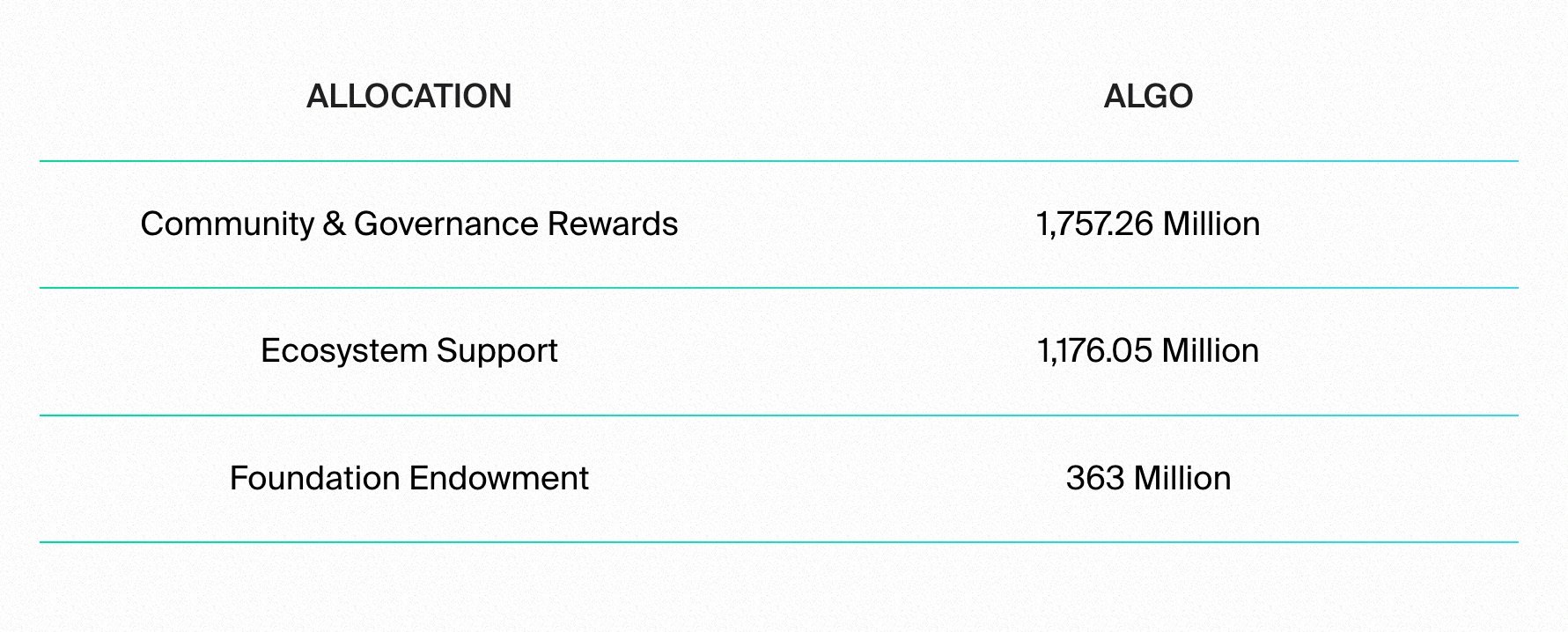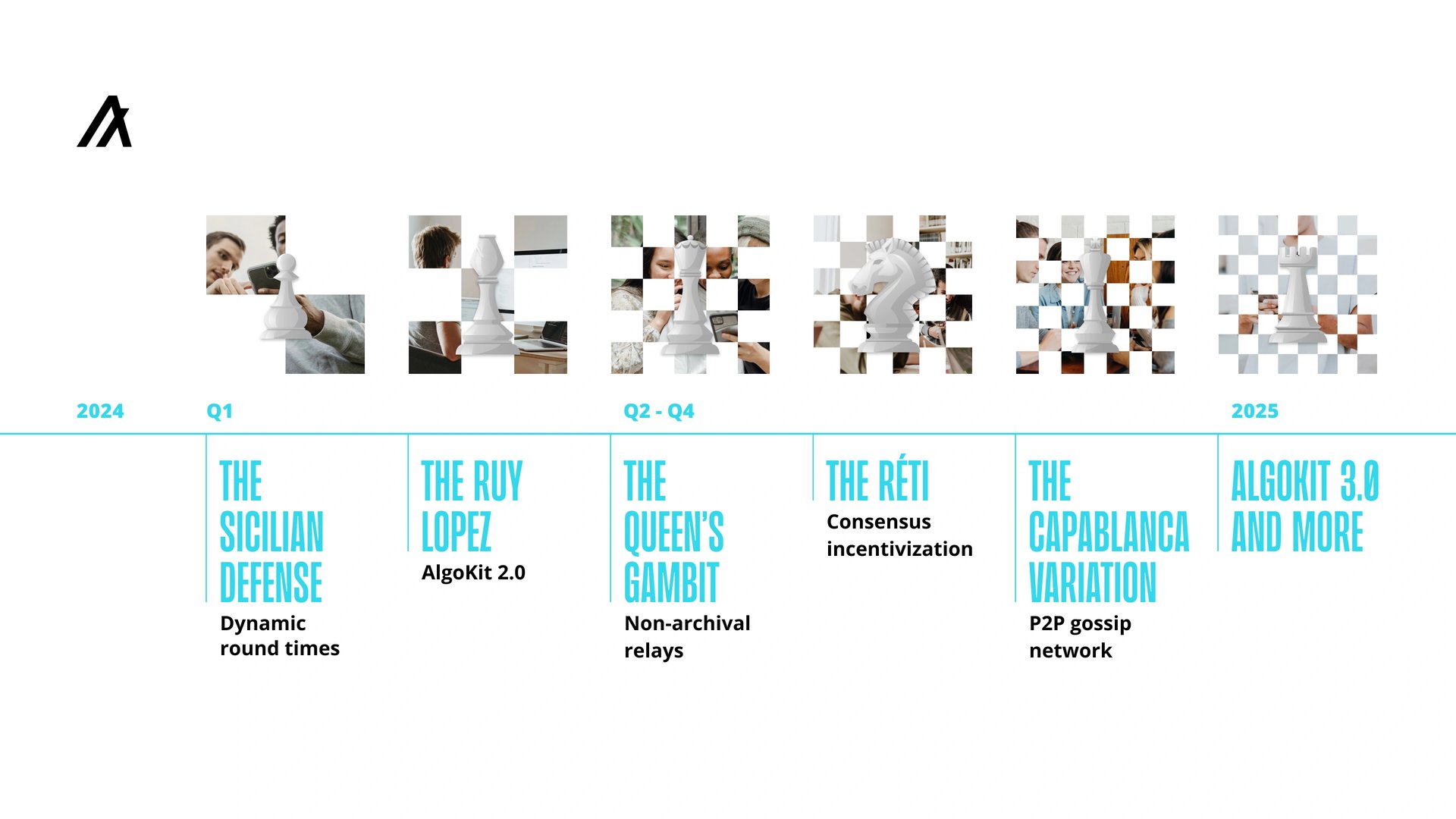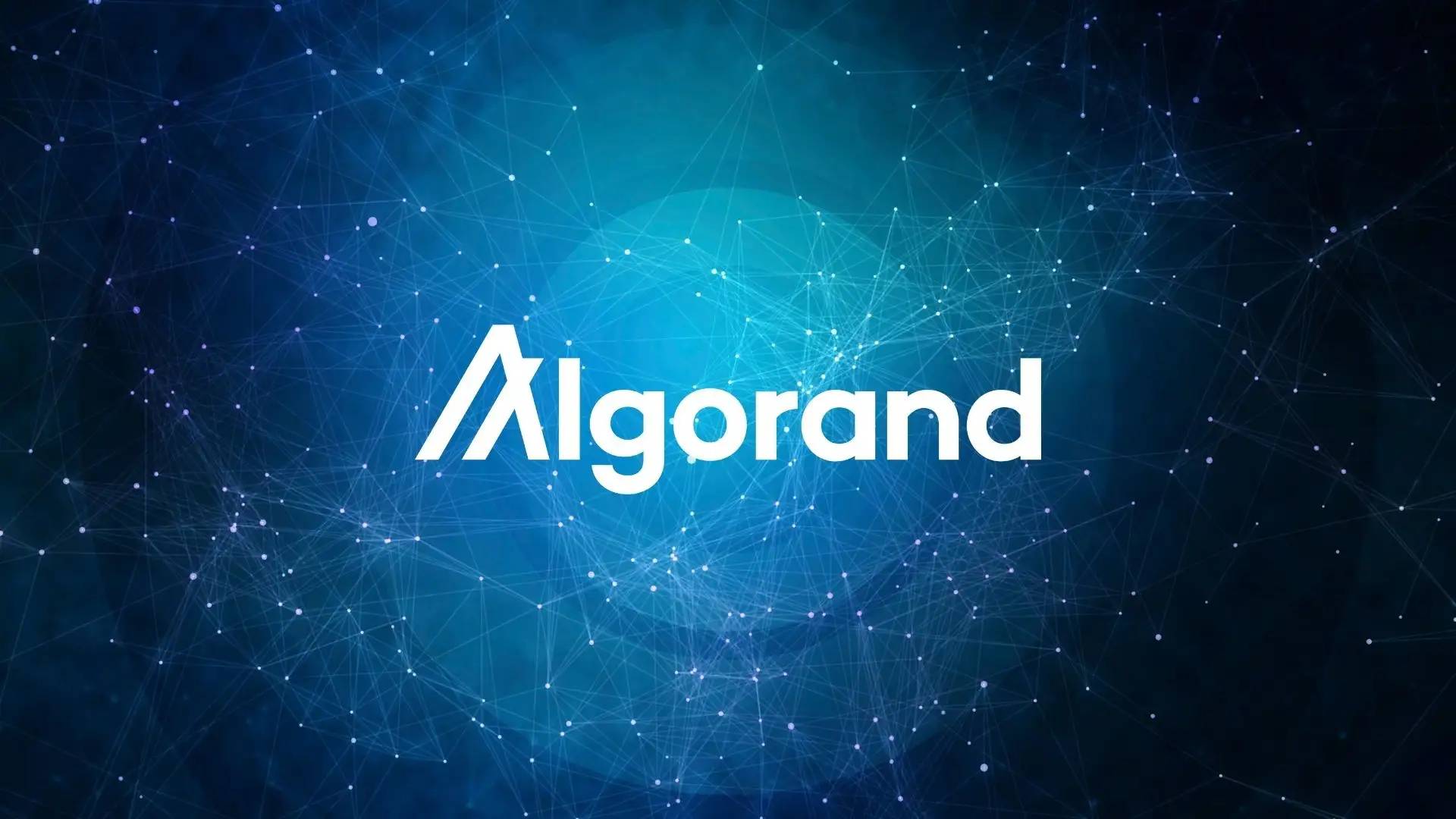위키 구독하기
Share wiki
Bookmark
Algorand
Algorand
알고란드(Algorand)는 누구든 분산형이고 허가가 필요 없는 네트워크에서 애플리케이션을 구축하고 가치를 전송할 수 있도록 하는 블록체인 프로토콜입니다. MIT 교수이자 암호학 분야의 권위자인 실비오 미칼리(Silvio Micali)가 2017년에 설립했습니다. 이 프로토콜은 순수 지분 증명(Pure Proof-of-Stake, PPoS)이라는 분산 합의 시스템을 사용하여 블록체인 기술이 직면하는 세 가지 주요 과제인 보안, 확장성, 분산성을 해결합니다.[1]
개요
알고란드 블록체인은 순수 지분 증명(Pure proof-of-stake, PPoS)이라고 하는 탈중앙화된 비잔틴 합의 프로토콜에 의존합니다. 이 프로토콜은 정직한 사용자(프로토콜을 준수하는 사용자)가 네트워크의 총 지분의 3분의 2 이상을 보유하는 한, 무제한의 악의적인 사용자를 허용할 수 있습니다. 이 프로토콜은 트랜잭션, 블록, 합의라는 세 가지 핵심 개념을 기반으로 합니다. 트랜잭션은 알고란드 네트워크의 기본적인 계정 단위이며, 가치를 전송하는 데 사용됩니다. 트랜잭션은 네트워크에 참여하는 모든 노드에 의해 검증됩니다. 블록은 함께 묶여 합의 알고리즘에 의해 검증되는 트랜잭션의 집합입니다. 합의는 블록이 검증되고 알고란드 프로토콜의 요구 사항을 충족하는지 확인하는 프로세스입니다. 또한 운영에 참여하는 사용자에게 보상을 제공합니다.[2][3]
건축 양식
프로토콜 구조
알고란드는 두 계층으로 구성됩니다. 1계층은 토큰과 같은 자산 생성 및 관리와 간단한 스마트 계약 실행에 주로 사용됩니다. 이러한 자산과 계약은 각각 알고란드 표준 자산(ASA, Algorand Standard Assets) 및 알고란드 스마트 계약(ASC1, Algorand Smart Contracts)으로 알려져 있습니다. 2계층은 보다 복잡한 스마트 계약 및 dApp에 할당됩니다. 이러한 분리는 2계층에서의 복잡한 활동으로 인한 속도 저하 없이 1계층에서 간단한 트랜잭션을 더 효율적으로 처리할 수 있도록 합니다. [14]
순수 지분 증명(Pure Proof-of-Stake)
작업 증명(PoW)은 거래를 검증하는 데 상당한 에너지가 필요하지만, 순수 지분 증명(PPoS)은 토큰을 스테이킹하고 참여 키를 생성한 알고랜드(Algorand, ALGO) 암호화폐 보유자를 무작위로 선택하여 체인의 각 블록을 검증합니다. 악의적인 활동에 참여하면 ALGO의 가치에 부정적인 영향을 미치므로, 보유자는 네트워크의 최상의 이익을 위해 행동하도록 유인됩니다. PPoS는 상당한 에너지 소비 없이 새로운 블록을 생성할 수 있게 합니다.[1]
지분 증명(PoS) 블록체인과 달리, 알고랜드는 최소 스테이크 요구 사항이 없으므로 사용자가 토큰을 스테이킹하여 검증자가 되는 것이 더 쉽습니다. 사용자가 새로운 블록 생성에 미치는 영향은 보유한 토큰 수에 비례합니다. 이는 네트워크의 보안이 소수의 대규모 이해 관계자에게 집중되는 것이 아니라 더 많은 사용자에게 분산되도록 합니다.[3][8]
핵심 프로토콜
알고란드 프로토콜에 참여하려면 사용자는 새로운 블록 생성에 참여할 수 있는 참여 키를 생성하고 등록해야 합니다. 알고란드 체인의 각 블록에는 검증자로 선택될 사용자를 결정하는 무작위 시드가 포함되어 있습니다. 이러한 사용자는 검증 가능한 난수 함수(VRF, Verifiable Random Function)라는 프로세스를 통해 선택되는데, 이 프로세스는 사용자의 개인 참여 키와 선택 시드를 사용합니다. 선택은 무작위로 비밀리에 이루어지며, 선택된 사용자만 자신이 선택되었는지 알 수 있습니다. 다른 사용자는 선택된 사용자가 합의 프로세스에 참여할 때까지 다음 블록을 생성할 사용자를 알 수 없습니다. 새로운 블록이 제안되면, 투표자 그룹 또는 위원회가 선택되어 해당 블록에 대해 투표합니다. 블록이 승인되어 블록체인에 추가되려면 합의에 도달해야 합니다.[3][8]
합의 단계
블록 제안
먼저, 새로운 블록을 제안할 계정이 선택됩니다. 네트워크의 모든 노드는 계정을 검증하고 검증 가능한 난수 함수(VRF, Verifiable Random Function)라는 프로세스를 사용하여 계정이 블록 제안에 선택되었는지 확인합니다. 계정이 선택되면 해당 계정이 유효한 제안자인지 확인하기 위해 노드를 통해 정보가 전파됩니다. 이 프로세스를 통해 알고랜드 네트워크는 안전하고 투명한 방식으로 새로운 블록을 제안할 계정을 선택할 수 있습니다.[3][8]
소프트 보팅
계정이 새로운 블록을 제안하도록 선택된 후, 네트워크의 노드는 검증 가능한 난수 함수(Verifiable Random Function, VRFC)를 사용하여 어떤 계정이 "소프트 보팅"을 할 수 있도록 선택되었는지 결정합니다. 이 과정에는 블록을 확인하기 위한 제안 필터링이 포함되며, 투표는 가장 낮은 VRFCertify 값을 가진 제안된 블록을 선택하는 데 사용됩니다. 이는 프로토콜의 보안 및 무결성을 보장하는 데 도움이 됩니다.[3][8]
투표 인증
계정이 블록 제안 프로세스에 참여하도록 선택되고 VRFCertify 값이 가장 낮은 제안된 블록이 선택되면 새로운 위원회가 블록 제안을 확인하기 위해 선택됩니다. 이전 단계와 마찬가지로 각 노드는 관리 계정을 거쳐 투표 프로세스에 참여합니다. 정족수에 도달하면 노드는 새 블록을 생성하고 원장에 기록합니다. 이는 새 블록이 유효하고 Algorand 프로토콜의 요구 사항을 충족하는지 확인하는 데 도움이 됩니다.[3][8]
상태 증명
2022년 9월, 알고란드는 신뢰할 수 없는 크로스체인 통신을 가능하게 하고, 초당 1,200건에서 6,000건으로 성능을 향상시키며, 개발을 용이하게 하고 dApp을 위한 온체인 난수 기능을 도입하는 새로운 도구를 제공하는 상태 증명(State Proofs)을 도입하는 프로토콜 업그레이드를 발표했습니다. 이러한 기능은 알고란드를 스포츠, 음악, 중앙은행 디지털 통화 및 탈중앙화 금융을 포함한 실제 세계 Web3 애플리케이션을 위한 선도적인 레이어-1 블록체인으로 자리매김하게 합니다. 상태 증명은 중개자에 대한 신뢰 없이 블록체인과 외부 시스템 간의 안전한 연결을 가능하게 하는 상호 운용성 표준입니다.[13]
사용 사례
2022년 12월, 알고란드(Algorand)는 자사의 생태계가 이탈리아의 은행 및 보험 보증 플랫폼 지원에 활용될 것이라고 발표했습니다. 밀라노 가톨릭 대학교 기술, 혁신 및 금융 연구 센터에서 블록체인 기술을 기반으로 디지털 증권 플랫폼을 개발하고 있습니다. 이 프로젝트는 코로나19 위기 이후 이탈리아의 경제 회복을 자극하기 위한 이탈리아 국가 회복 및 회복력 계획의 일환입니다.[15]
ALGO
ALGO는 알고랜드 블록체인에서 사용되는 암호화폐입니다. 2019년 6월 알고랜드의 메인넷과 함께 출시되었습니다. ALGO의 ICO는 2019년 6월 토큰당 $2.4의 가격으로 진행되었습니다. ALGO는 거래를 용이하게 하고 알고랜드 네트워크 운영에 참여하는 사용자에게 보상을 제공하는 데 사용됩니다.[4]
토큰 경제학
알고랜드 프로토콜이 시작될 때, 100억 개의 ALGO 토큰이 생성되었습니다. 이 토큰들은 커뮤니티 인센티브 및 생태계 지원을 포함한 다양한 채널을 통해 배포됩니다. 알고랜드 재단은 총 ALGO 공급량의 일부를 보유하고 있으며, 커뮤니티 및 거버넌스 보상으로 1,757.26백만 개, 생태계 지원으로 1,176.05백만 개, 재단 기금으로 3억 6300만 개가 할당되었습니다. ALGO 토큰의 배포는 알고랜드 네트워크의 성장과 개발을 지원하도록 설계되었습니다.[5]

지속가능성
알고란드는 "세계에서 가장 강력하고 지속 가능한 블록체인"이라고 주장합니다. 설립자에 따르면, 이 프로토콜은 처음부터 지속가능성에 중점을 두고 설계되었으며, ClimateTrade와 같은 지속가능성에 중점을 둔 단체들과의 파트너십을 통해 알고란드는 지속 가능한 블록체인이 되기 위해 노력하고 있습니다. 설계 및 파트너십에서 지속가능성을 우선시함으로써, 이 프로토콜은 친환경 기술을 장려하는 더 광범위한 목표에 기여하고자 합니다.[6]
알고란드는 지분 증명 방식의 변형으로 구동되는 공개 블록체인을 개발했는데, 이는 전력 소비량을 거의 제로에 가깝게 만듭니다…근본적인 수준에서 - 실비오 미칼리
알고랜드 재단 (Algorand Foundation)
알고랜드 재단은 알고랜드 블록체인의 개발과 채택을 지원하기 위해 설립된 비영리 단체입니다. 여기에는 프로토콜 거버넌스, 토큰 역학 및 알고랜드 생태계 내 오픈소스 개발이 포함됩니다. 알고랜드 블록체인의 채택을 촉진하는 프로젝트와 이니셔티브를 만들기 위해 생태계와 협력합니다.[12]
재단은 MIT와 UC 버클리와 같은 기관을 포함하는 글로벌 대학교 프로그램을 통해 대학 및 기타 교육 환경에서 개발자 교육을 지원합니다. 또한 블록체인 이벤트, 해커톤, 교육 수업 및 인증을 후원합니다. 2020년 알고랜드 재단은 알고랜드 아시아 액셀러레이터와 알고랜드 유럽 액셀러레이터라는 두 개의 액셀러레이터 프로그램을 시작하여 알고랜드 블록체인을 기반으로 구축하는 데 관심 있는 진행 중인 프로젝트와 개발자를 지원했습니다. 이러한 프로그램은 전략 수립부터 출시까지 포괄적인 지원을 제공하여 프로젝트가 성공하고 알고랜드 생태계의 성장에 기여하도록 돕습니다.[14]
알고랜드 재단 이사회는 Kieron Guilfoyle, Pino Persiano 및 Staci Warden으로 구성됩니다. 주요 프로젝트로는 Folks Finance, Algofi, Gard, Tinyman, Humble Defi, Pact, Lofty AI, Algodex, Nfdomains 및 C3가 있습니다.[12]
팀
알고랜드의 팀은 연구원, 수학자, 암호학자, 경제학자 및 글로벌 비즈니스 리더들로 구성됩니다. 설립자인 실비오 미칼리(Silvio Micali)는 튜링상(Turing Award)과괴델상(Godel Prize)을 수상한 저명한 암호학 분야의 인물입니다.[7]
다른 중요한 구성원으로는 다음과 같습니다.
- W. 션 포드(W. Sean Ford), 임시 CEO
- 폴 리글(Paul Riegle), CPO
- 징 첸(Jing Chen), 이론 연구 책임자 겸 수석 과학자
- 요시 길라드(Yossi Gilad), 시스템 연구 책임자 겸 최고 기술 책임자
- 게리 말루프(Gary Malouf), 엔지니어링 책임자
- 레지나 오브라이언(Regina O’Brien), 인사 및 인재 책임자
- 크리스 페이커트(Chris Peikert), 암호학 책임자
- 미셸 퀸타글리(Michele Quintaglie), CMO
- 앤 티. 워너(Anne T. Warner), 법률 고문
Decipher Conference
Decipher Conference는 알고란드(Algorand)가 주최하는 연례 행사로, 개발자, 창업자, 투자자, 전략가들이 모여 프로토콜의 미래에 대해 논의하는 자리입니다. 이 행사에서는 참가자들이 대화, 네트워킹, 그리고 생태계를 탐구하는 실습 세션에 참여할 수 있습니다. [9]
Decipher 2024는 2024년 6월 바르셀로나에서 개최될 예정입니다. [16]
Decipher 2021
2021년 첫 행사는 플로리다주 마이애미에서 11월 29일부터 30일까지 개최되었습니다. 연사로는 Arrington Capital 설립자인 Michael Arrington, CoinShares 최고 전략 책임자인 Meltem Demiros, SkyBridge Capital 설립 겸 운영 파트너인 Antony Scaramucci, 그리고 Chamber of Digital Commerce 설립자 겸 회장인 Perianne Boring 등이 참여했습니다. 이벤트 기간에는 INNOVATE 글로벌 해커톤이 열렸으며, 참가자들은 오픈 트랙, 미래 금융(FutureFi) 트랙, 디지털 아트/수집품 트랙 중 하나에 참여할 수 있었습니다. 10만 달러가 넘는 상금이 수여되었습니다.[10]
Decipher 2022
2022년 11월 28일부터 30일까지 두바이(Dubai)에서 열린 Decipher 2022에는 전년 대비 증가한 2,000명 이상의 참석자가 모였습니다. 이 컨퍼런스에서는 Algorand Foundation이 Algorand 생태계 구축 및 투자에 참여하는 사람들에게 자금과 지원을 제공할 Algorand Ventures를 출시하는 등 여러 중요한 발표가 있었습니다. 세인트 빈센트 드 폴 재난 구호 서비스(St. Vincent De Paul Disaster Services)는 또한 Algorand 블록체인 기반의 재난 구호 플랫폼인 Kokua를 공개했습니다. 또한 Algorand Foundation은 Binance 거래소에서 USDC 지원을 발표하고 Anil Kakani를 AlgoBharat 이니셔티브를 이끌 인도 국가 책임자로 임명했습니다.[11]
2024년 로드맵
알고란드는 합의 달성 및 피어투피어(P2P) 가십 네트워크로의 전환을 위한 인센티브를 구현하고 있습니다. 이러한 변화는 사용자 제어를 강화하고 블록체인 네트워크의 자율성을 높이도록 설계되었습니다. [17]

시칠리아 방어: 역동적인 라운드 시간
이 업그레이드를 통해 블록 시간은 평균 3초 미만이 될 것으로 예상됩니다. 역동적인 라운드 시간의 유연성은 Algorand 네트워크의 효율성과 확장성을 향상시켜 개발자들에게 이점을 제공합니다. 최종 사용자는 POS(Point-of-Sale) 거래 속도와 유사한 더 빠른 확인을 경험하여 블록체인과의 원활한 상호 작용을 얻게 됩니다. [17]
이 프로토콜 업그레이드는 1월 10일 Algorand 네트워크의 투표를 통해 승인되었으며 1월 17일에 구현되었습니다. [17]
루이 로페즈: 알고킷 2.0
알고킷 2.0은 알고랜드에서의 구축, 테스트 및 배포 프로세스를 용이하게 하도록 설계된 포괄적인 도구 세트를 제공합니다. 사용자를 위한 간편한 10분 온보딩 프로세스가 포함되어 있습니다. 2024년 내내 알고킷에 대한 추가 업그레이드가 계획되어 있으며, 로컬넷 및 샌드박스 개선을 통해 더욱 풍부한 실험 환경을 제공할 예정입니다. Python 단위 테스트 도입은 사용자가 안전한 코드를 작성하는 데 도움이 되는 반면, 시각적 디버거 도구는 문제를 효율적으로 식별하고 해결하는 데 도움이 될 것입니다. [17]
퀸스 갬빗: 비보관 릴레이
네트워크가 성장함에 따라 릴레이 노드는 데이터를 효율적으로 전송하고 전체 원장 내역을 저장하는 데 필요한 에너지 요구 사항이 증가하는 것을 관리해야 합니다. 더 많은 비율의 릴레이를 비보관 상태로 전환하는 것은 네트워크를 더 효율적이고 환경 친화적으로 만들고 비보관 릴레이를 실행하는 데 드는 비용을 줄이는 것을 목표로 합니다. 이러한 릴레이는 계속해서 기능하지만 부가가치 서비스 역할을 하여 더욱 간소화된 알고랜드 생태계에 기여할 것입니다. [17]
레티: 합의 인센티브화
알고랜드는 L1 동작을 조정하여 블록 생성자에게 보상을 제공함으로써 참여에 대한 직접적인 인센티브를 구현할 것입니다. 이 조정은 알고(Algo)의 스테이킹 증가와 합의 노드 수 증가를 가져와 네트워크 보안 및 분산화를 개선할 것으로 예상됩니다. [17]
카파블랑카 변형: P2P 가십 네트워크
알고랜드는 릴레이 구조에서 비트코인 및 기타 많은 암호화폐 네트워크의 작동 방식과 유사한 피어투피어(P2P) 가십 네트워크로 전환하고 있습니다. 이 모델에서는 데이터가 합의 노드 간에 직접 흐르므로 릴레이 노드에 대한 의존성이 줄어들고 분산화가 촉진됩니다. [17]
잘못된 내용이 있나요?
